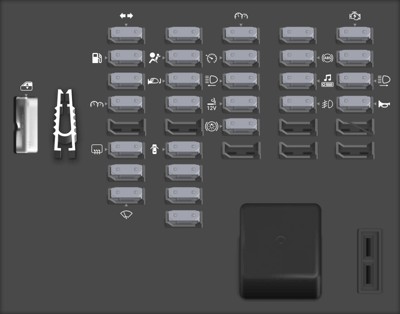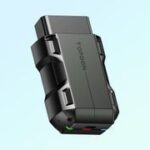The 2000 Chevrolet Cavalier utilizes the OBD2 (On-Board Diagnostics II) system for diagnostics and troubleshooting. While the OBD2 port itself doesn’t have a dedicated fuse, various fuses within the vehicle’s fuse boxes protect the circuits and components related to the OBD2 system. This guide will help you understand the 2000 Chevy Cavalier’s fuse box layout and identify the fuses that could affect OBD2 functionality.
Understanding the 2000 Chevy Cavalier Fuse Box System
The 2000 Chevy Cavalier has two primary fuse boxes:
- Instrument Panel Fuse Block: Located on the driver’s side, under the dashboard, this fuse box houses primarily MINI fuses and protects components within the cabin.
- Engine Compartment Fuse Block: Situated under the hood, usually near the battery, this fuse box contains both MAXI and MINI fuses and protects components within the engine bay.
Understanding which fuse box and which specific fuse protects what component is crucial for troubleshooting. Below are detailed breakdowns of each fuse box and the components they protect, focusing on those that might affect your OBD2 system.
Instrument Panel Fuse Box: Key Fuses for OBD2
This fuse box primarily uses MINI fuses. Several fuses here could impact the OBD2 system:
- PCM (Powertrain Control Module): The PCM is the brain of the engine and transmission, directly interacting with the OBD2 system. A blown PCM fuse can disrupt communication with the OBD2 port.
- BCM/CLU (Body Control Module/Instrument Panel Cluster): The BCM manages various body functions, and some of its data is accessible via OBD2. A faulty BCM/CLU fuse could affect data retrieval.
- CIG (Cigarette Lighter, Diagnostic Link Connector): While seemingly unrelated, the CIG fuse often protects the circuit that powers the OBD2 port itself. A blown CIG fuse could render the OBD2 port inoperable.
- IGN MDL (Ignition Module): The ignition system plays a vital role in engine operation, and relevant data is relayed through the OBD2 system.
Engine Compartment Fuse Box: OBD2 Related Fuses
This fuse box uses both MAXI and MINI fuses. Here are the critical fuses:
- PCM/HVAC (Powertrain Control Module/Heater and A/C Blower): Similar to the instrument panel’s PCM fuse, this fuse can impact OBD2 communication if blown. This fuse might be a MAXI fuse.
- PCM (Powertrain Control Module) (MINI Fuse in Engine Compartment): This may be a separate fuse dedicated to specific PCM functions and can also affect OBD2 data.
- IGN (Ignition Switch Circuits): A MAXI fuse, this protects the overall ignition system, and any issue here can disrupt OBD2 functionality.
Troubleshooting OBD2 Issues Related to Fuses
If your OBD2 scanner isn’t communicating with your 2000 Chevy Cavalier, checking these fuses is a crucial first step:
- Safety First: Always disconnect the negative battery terminal before working with fuses.
- Visual Inspection: Carefully examine each fuse related to the OBD2 system for signs of damage, such as a broken filament or discoloration.
- Fuse Replacement: If a blown fuse is found, replace it with a fuse of the same amperage rating. Never use a higher amperage fuse.
- Consult Your Owner’s Manual: Always refer to your owner’s manual for the precise location and amperage rating of each fuse.
Conclusion
Locating the right fuse for OBD2 related issues in your 2000 Chevy Cavalier requires understanding the layout of both fuse boxes. While the OBD2 port doesn’t have a dedicated fuse, several fuses protect related circuits. This guide, coupled with your owner’s manual, should provide the necessary information for effective troubleshooting. Remember to always prioritize safety and consult a professional if you’re unsure about any procedure.


